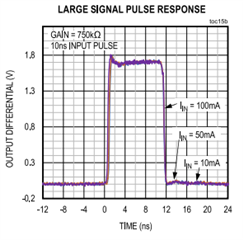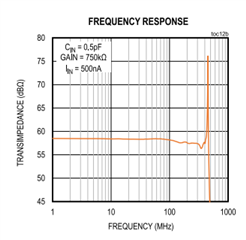Other Parts Discussed in Thread: OPA855, OPA3S2859, OPA859
I'm trying to make a circuit to detect single-photon pulses on an avalanche photodiode (APD). I'm starting with an S14422 APD.
I don't have a model for the current pulses associated with a photon. I have been testing an APD module, C13367. The module's amplifier circuit outputs pulses in the 100mV, 10ns range. I don't know what the signal from the APD itself looks like.
Not having a circuit model for my APD, I'm trying to understand the figures of merit for transconductance amplifiers.
LMH32401 has built-in feedback resistors of 1k and10k. That is small compared to the MAX40213, whose gain options are 150k or 750k. My first thought is a part with this much gain would have poor high-frequency response, but look at this nice square 10ns pulse:

Does TI have a high speed part comparable to MAX40213? Are there tradeoffs that come with such high transimpedance? What figures of merit should I be looking at to see the tradeoffs?


